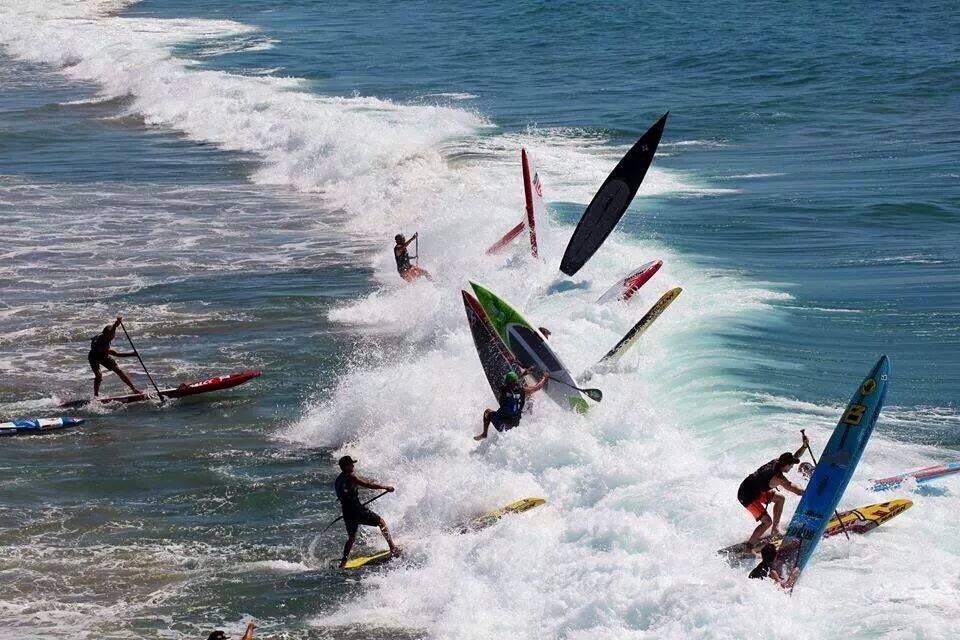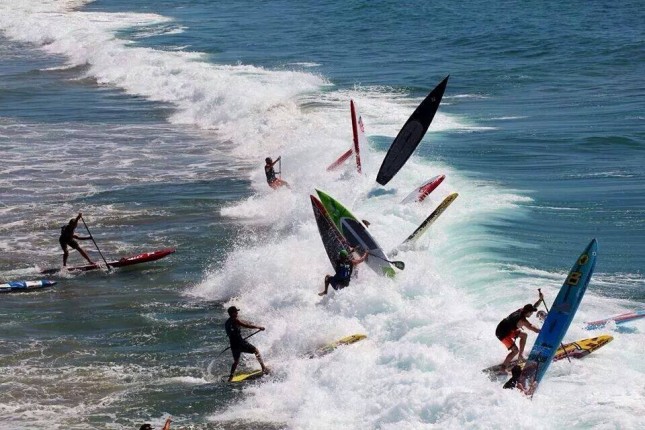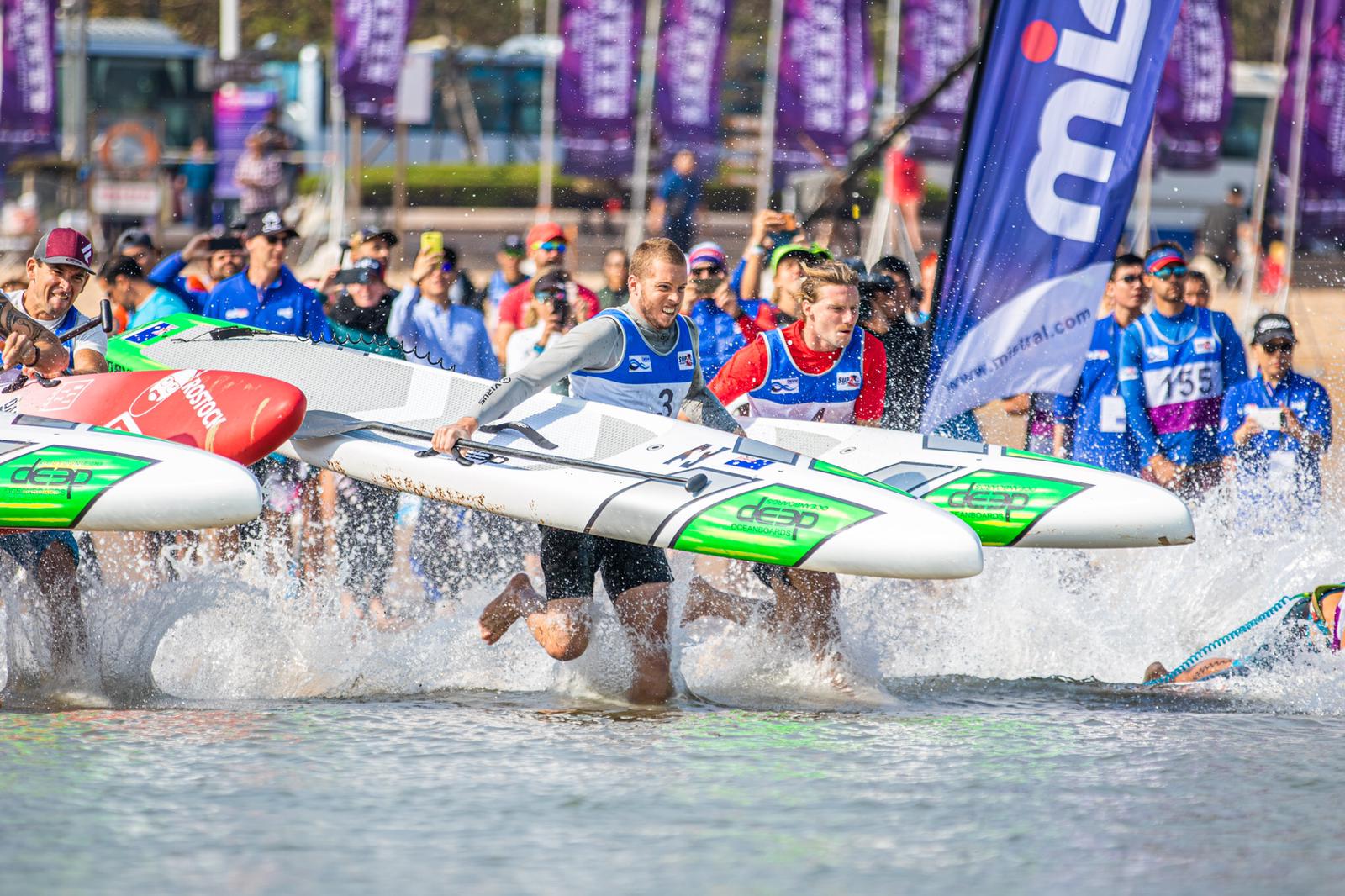
Stand Up World Series: The Waterman League Is on the Brink of ‘Going Big’ or ‘Going Bust’

A rather symbolic representation of the Waterman League… (photo from World Series Huntington by Ke’ale Dorries)
These are interesting times for the Waterman League. The fledgling company that’s been trying to establish a professional, global racing tour for the past half a decade is now on the brink. On the brink of finally going big, but also on the brink of going totally bust.
For the fourth year in a row, and despite months of promises to the contrary, the Waterman League has begun a new season without having paid for the last one. Athletes are owed tens of thousands of dollars from season 2015, while there are serious doubts about several of the proposed events on the 2016 Stand Up World Series schedule.
But despite all the problems, the Waterman League is confidently talking up a big future. And in some ways they have a good reason to be. Here’s what we know so far:
– There was no prize money for the Sunset Beach Pro in Hawaii last week.
– Waterman League founder/CEO Tristan Boxford addressed athletes at Sunset and admitted there was essentially no money left in the bank, but that he was working hard to raise a big round of financing.
– There was a mix of ‘Groundhog Day’ frustration and optimistic hope among the athletes; everyone agreed to go ahead with the Sunset contest (the surf was pumping after all).
– Looking further back: In September 2015, the Waterman League began trying to raise capital through a group of Canadian investors. This is why they initially promised all prize money would be repaid by the end of October 2015, and that all 2016 events would have a $50,000 purse. But they jumped the gun: The Canadian deal fell over before the end of the year.
– When it became clear the Canadian deal was faltering, the Waterman League began seeking a new deal, striking up a relationship with Los Angeles-based sports investment firm Park Lane. This potential new deal sounds promising but is in no way guaranteed.
– The 2016 Stand Up World Series schedule (which has still yet to be officially released) is in total limbo, and I know of at least four of the seven proposed racing events (San Fran, Japan, Barcelona, Hamburg, Canada, Huntington, Turtle Bay) that are at risk of not happening.
– The only bright spot appears to be the “Red Bull Heavy Water” men’s invitational in San Francisco next month. Red Bull is putting up the $50,000 purse (and record $20,000 first place prize), so it sounds legit. Expect an official announcement next week, and expect a pretty solid lineup of top ranked guys to be there next month.
But let’s get back to this potential investment deal with Park Lane, because that seems to be the Waterman League’s best (and perhaps only) chance of salvation at this stage.
Reading straight from their About page, Park Lane can be described as:
“…an investment bank founded to provide sports finance advisory services to a variety of clients in the sports industry. Our bankers supply mergers and acquisitions advisory, corporate finance, consulting, financial advisory, and restructuring to sports leagues, teams, investors, and sports-related businesses. We combine in-depth financial expertise with unparalleled access for our clients.”
Or in other words: Exactly what the Waterman League needs right now.
The deal is being led by Park Lane’s “Entrepreneur-in-Residence” Robert Reynolds, a keen surfer from SoCal that believes in the future of stand up paddling as a professional sport.
Robert addressed paddlers during the Sunset Beach Pro athlete meeting last week, and I got the cliff notes from several of those in attendance. The general mood in the room was one of cautious optimism; Many athletes said it sounded like “Just more big promises,” but that at least it was coming from someone outside the Waterman League for a change. It was this crucial point that gave many athletes I spoke with reason to be somewhat optimistic.
(I also emailed Robert with follow-up questions and will update this article if he responds.)
Park Lane’s strategy for the Waterman League is three-fold:
– Second, Park Lane will attempt to raise between $3 million and $5 million in order to give the Waterman League a solid platform for the next few years.
– Third, Park Lane will provide much-needed management advice and expertise.
– Park Lane is committed to this project for at least the next six months, which is both a good and a bad thing: The firm obviously believes in the sport, however unless Park Lane can secure a quick bridge loan, the Waterman League’s money troubles may not be resolved before the second half of the year.
– Park Lane will raise and manage funds from private investors, which will amount to a large ownership stake in the Waterman League (possibly a controlling share). Their strategy is to target wealthy individuals that already have a connection to the paddling world — a prospectus will be sent to potential investors by the end of February.
Robert, and by extension Park Lane, appear to be the Waterman League’s only real chance of survival at this stage. The company is broke and on the brink, but if Park Lane can raise up to $5,000,000 as promised, it’ll be happy days for everyone. They’ll finally be able to go big and realise the grand vision they’ve been promising for the past five years.
Will this last roll of the dice work? Only time will tell. It certainly seems like a risky investment, however Tristan Boxford could sell ice to the eskimoes, while his new business partner represents a legit investment firm that seems to genuinely believe in the future of the company and the sport. So in other words: They’ve probably got a half-decent chance of raising the money.
And there’s a lot at stake.
While the Stand Up World Series (racing) will only make a small dent on the sport if it falls over – the majority of top athletes don’t follow it anyway, while most of the biggest races in the world are standalone events – the Stand Up World Tour (surfing) is critical to that side of the sport.
Apart from the once-a-year ISA Worlds, the World Tour is basically the only show in town for professional SUP surfers. So if that falls over, it’s going to leave a big hole for the athletes and the sport in general. While the racing athletes have plenty of other options, the only other avenue for the surfers would be to go off on their own and pursue a free-surfing career (which may actually be a wise move).
Even though I’m one of their biggest critics, I actually really admire the Waterman League — those guys have definitely got some brass balls. While I certainly don’t admire their business ethics, or lack of (indeed, many athletes I spoke to vented their frustrations at the seemingly endless string of broken promises), I do give them credit for their resilience and determination.
And despite all the stumbles, let’s not forget the Waterman League has actually done some good things for the sport, while also giving a small group of top junior athletes the opportunity to pursue a career in the ocean.
Running a business is hard, especially a bootstrapped one that’s operating in a turbulent economy with a sport that’s going through its fair share of growing pains. And there’s nothing necessarily wrong with a company being in debt; Amazon famously failed to make a profit for its first eight years, while, closer to home, the Ironman Corporation (which basically owns the triathlon world), was sold for $650 million last year despite being in the red.
I’m a big fan of the Silicon Valley startup ethos, I just wish the Waterman League had Silicon Valley levels of venture capital to play around with — perhaps that’ll finally change in the next few months.
As I wrote in my previous article (“7 Ways To Save the Waterman League“), the company loves saying how its events are always going to be “exciting and dramatic.” And I guarantee that season 2016 will be: Sparks will fly, rollercoasters will be ridden and there will never be a dull moment on the Stand Up World Series.
Let’s just hope all that stuff happens on the water this year, not off it…



